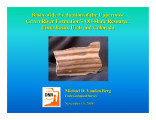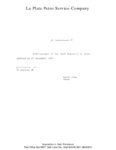TO
| Title | Date | Subject | Description | ||
|---|---|---|---|---|---|
| 226 |
 |
Availability of tar sands on public land: An overview | 2006-09-21 | Tar sands; public lands; Utah; Leasing on federal lands; Hydrocarbonaceous material; Oil shale; Tar sand development | Presentation summary: 1-Provide an overview of Utah Tar Sand Resources 2-Provide historical summary Tar Sand Leasing on Federal Lands; -Early leasing efforts-1960, -Combined Hydrocarbon Leasing-1981, -Energy Policy Act of 2005 3-Outline current leasing process |
| 227 |
 |
Balancing energy resources | 2008-05-23 | Utah; Rocky Mountain Power; Wyoming; Utah Energy; Energy deficit; Greenhouse gas; Energy resources; Coal | Fulfilling our obligation: 1-Investing in the system to satisfy growing demand 2-Meeting increasing customer expectations with respect to the quality of our service 3-Addressing increasing concerns regarding the environment |
| 228 |
 |
Barriers to industrial development in Utah's portion of the four corners region | 1970-06-01 | Utah's portion of the Four Corners area is composed of the 21 counties which are south and/or east of Salt Lake County. The Utah Four Corners area covers 65,000 square miles which is approximately 80 percent of the state. The are a has a population of 274,500 dispersed throughout the region in a ver... | |
| 229 |
 |
Baseline scenario 1997 | 1997-09 | ||
| 230 |
 |
Baseline scenario 1998 | 1998-02 | ||
| 231 |
 |
Basic Institutional Data for the University of Utah | 2006-08-30 | Accreditation; Higher Education, University of Utah | Northwest Commission on Colleges and Universities Basic Institutional Data Form for the University of Utah |
| 232 |
 |
Basin oriented strategies for CO2 enhanced oil recovery: Alaska | 2005-04 | Alaska; North Slope; Cook Inlet; Oil; Gas; Oil recovery; EOR; CO2; Carbon dioxide; Oil fields; Oil production industry | The oil and gas producing regions of Alaska have nearly 45 billion barrels of oil which will be left in the ground, or "stranded", following the use of today's oil recovery practices. A major portion of this "stranded oil" is in reservoirs technically and economically amenable to enhanced oil recove... |
| 233 |
 |
Basin oriented strategies for CO2 enhanced oil recovery: Rocky Mountain Region | 2006-02 | Rocky Mountain; Colorado; Utah; Wyoming; Oil; Gas; Enhanced oil recovery; EOR; CO2; Carbon dioxide injection; Oil fields; Basin oriented strategies; Domestic oil production | The Rocky Mountain oil and gas producing region of Colorado, Utah and Wyoming has an original oil endowment of nearly 34 billion barrels. Of this, 11 billion barrels (33%) has been produced or proven. As such, nearly 23 billion barrels of oil will be left in the ground, or "stranded", following the ... |
| 234 |
 |
Basin-wide evaluation of the uppermost Green River Formation's oil-shale resource, Uinta Basin, Utah and Colorado | 2008 | Green River; Uinta Basin; Utah; Colorado; Crude oil; Green River Formation; Oil; Gas; Oil yield; Oil shale; Oil-shale thickness; Mahogany zone; R-7; Parachute Creek Member; Richness grade; Uintah County; Salt Lake Base Line and Meridian; BLM; U.S. Bureau of Land Management | Due to the recent increase in crude oil prices and concerns over diminishing conventional reserves, the Utah Geological Survey has reexamined the Uinta Basin's oil-shale resource, primarily in the Mahogany zone of the Green River Formation. Past assessments, the first conducted in 1964 and subsequen... |
| 235 |
 |
Basin-wide evaluation of the uppermost Green River Formation's oil-shale resource, Uinta Basin, Utah and Colorado | 2008-11-13 | Presentaion; Green River formation; Oil shale; Uinta Basin; Utah; Colorado; Oil-shale resource evaluation; UGS; Isopach maps | Scope--Oil Shale Resource Evaluation: 1) Focus - Entire Uinta Basin - Data from 293 wells spread throughout the Uinta Basin 2) Determined thickness of continuous intervals averaging 50, 35, 25, and 15 gallons per ton (GPT) 3) Created GIS-based maps - Isopachs for each richness zone - Overburden thic... |
| 236 |
 |
Best practices for maintaining personal and departmental files | 2008-11-12 | Documents management; File storage; Best practices | In today's ever changing work environment, there is a need to maintain both paper-based and electronic files. This document is a guide to assist users with efficient paper-based file management. |
| 237 |
 |
Bibliography of oil-impregnated rock deposits of Utah | 1979-11 | ||
| 238 |
 |
Bibliography of tar sand deposits in Utah | 1987 | ||
| 239 |
 |
Biofuels--snake oil for the twenty-first century | 2008-12-01 | Most Americans are painfully aware that our present consumption of petroleum is unsustainable. The United States has less than 5% of the world's population, but consumes 24.4% of the world's petroleum production. Only 8.5% of the world's petroleum production comes from American wells, which necessit... | |
| 240 |
 |
Biological markers from Green River kerogen decomposition | 1981-09 | Isoprenoid and other hydrocarbons that are formed in living organisms and preserved in ancient sediments are often called biological markers. The purpose of this paper is to develop improved methods of using isoprenoid hydrocarbons to trace petroleum or shale oil to its source. It is demonstrated th... | |
| 241 |
 |
Biomakers in oil shale: Occurrence and applications | 1982-10 | Biological markers, compounds derived essentially unchanged from living organisms, are found in oil-bearing rocks, petroleum and most ancient sediments. We are investigating the variation in ratios of certain biomarkers in shale oils and their use as tracers for relating oil to source rock during in... | |
| 242 |
 |
Bitumen and very heavy crude upgrading technology: A review of long term R&D opportunities | 2004-03-31 | bitumen; very heavy crude; upgrading technology; R&D opportunities; upgrade bitumen; oil sands bitumen | The Focus of this Review: This review has focused on the identification of emerging and developing technologies that can, when fully developed, either be applied directly to upgrade bitumen and very heavy crudes, or are integral to new approaches to upgrading. Although very heavy crudes do not have ... |
| 243 |
 |
Bitumen deposits of northwest Alabama | 1987 | bitumen deposits; northwest Alabama deposits; bituminous rocks | Bituminous rocks of Mississippian age crop out in northwest Alabama within a 113-km (70-mi) long belt. Bitumen deposits have been confirmed by coreholes to be present in the subsurface for a distance of at least 16-24 km (10-15 mi) south of the outcrop. Geochemical analyses indicate the bitumen to b... |
| 244 |
 |
Bitumen recovery from tar sands | 1984-09-11 | Patent; Bitumen recovery; Tar sands; Kerosene; Flotation cell; Bitumen | A process for recovering bitumen from tar sands wherein the tar sands are pretreated with a diluent, such as kerosene in the preferred embodiment, to lower the viscosity of the bitumen such that it is in the range of about 5 to about 20 poise at the digestion temperature. The tar sands are then dige... |
| 245 |
 |
Bituminous sands and some legal aspects of leasing | 1964 | A brief description of the more important bituminous sand deposits of Utah at Asphalt Ridge, Sunnyside, Whiterocks River, and other localities. Discussion of their probable origin and present physical qualities with comparison to liquid oil and natural solid bitumen deposits in Utah. Capsule history... | |
| 246 |
 |
Bituminous sands and viscous crude oils | 1964-10-10 | Bituminous sands; Viscous crude oils; Rocky Mountain region; Low gravity; high viscosity; Heavy crude oil; Quiet Revolution; Thermal recovery; Utah; Bituminous sandstone deposits | Bituminous sandstones of the Rocky Mountain region contain large reserves of low gravity, highly viscous oil that can be recovered at costs equal to or less than the cost of finding and producing oil from conventional methods. Heavy crude oil is defined as "oil which cannot be produce through the no... |
| 247 |
 |
Bituminous sandstone and limestone deposits of Utah | 1963 | The significant bituminous sandstone and bituminous Limestone deposits of Utah are located within, or on the edges of, the Uinta Basin. They are all located within the boundaries of Carbon, Duchesne, and Uintah Counties. The Sunnyside deposits in Carbon County contain the greatest reserves of bitumi... | |
| 248 |
 |
Bituminous sandstone deposits Asphalt Ridge | 1966-12 | Asphalt Ridge probably is the second largest bituminous sandstone deposit in northeastern Utah's Uinta Basin. Discontinuous concentrations of bitumen occur in the Rim Rock Sandstone of the Mesaverde Group of Cretaceous age, in the overlying Uinta Formation of Eocene age and the Duchesne River Format... | |
| 249 |
 |
Bituminous sandstones in the Uinta Basin | 1964 | The largest single deposit of bituminous sandstones in the United States is found in the Uinta Basin. This deposit along with two other well known occurrences of bituminous sandstones in the northeastern portion of the basin have proved reserves exceeding 1% billion barrels of oil. The reserve calcu... | |
| 250 |
 |
Brief history and recent developments in tar sand deposits of Uinta Basin | 1985 | Commercial production of oil from bituminous sandstones, more commonly referred to as "Tar sands", is considered by many to be a viable project. These so-called "heavy oil" deposits represent a very considerable reserve of oil for the future. The Uinta basin is Mother Nature's storehouse of exotic b... |
